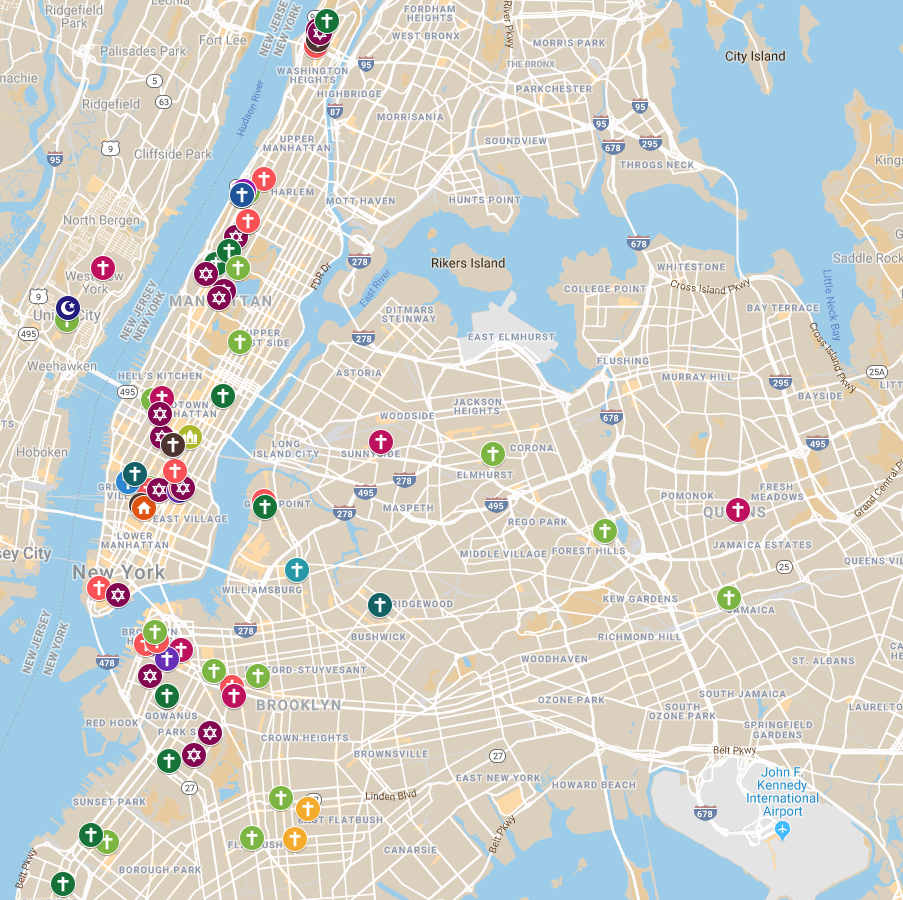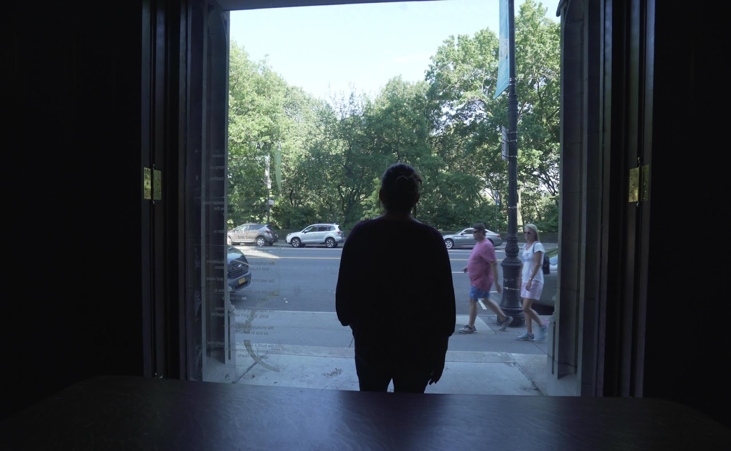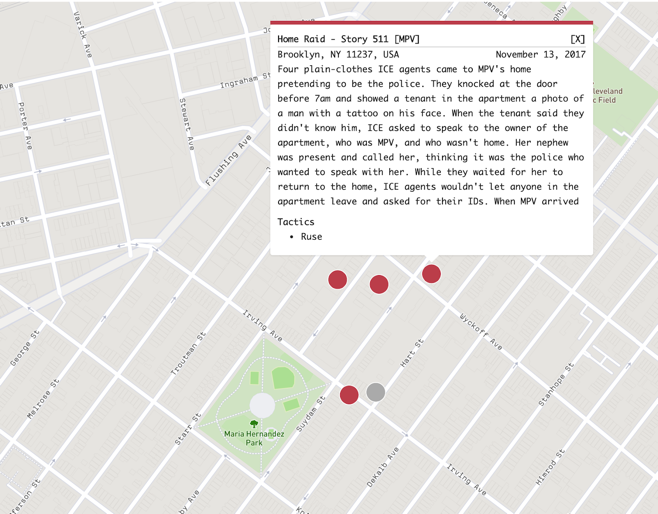Sacred Ground
Madeline Gunderson
‘I’ve Got to Move the Body’
Critics Say Immigrants Still Dehumanized in Sanctuary City
By Madeline Gunderson
TRIBECA– Reverend Micah Bucey accompanied a Haitian woman to her Immigration and Customs Enforcement (ICE) check-in at 26 Federal Plaza in Manhattan. The hours passed as he waited for her to reappear in the lobby. Growing anxious, he pestered the agents, asking to know what had happened to her.
Five hours had passed before he learned that she had been detained. The agents allowed him to say goodbye, and Reverend Bucey described seeing the woman detained, shivering in a corner out of fear.
“While [I’m] hugging her…an ICE agent comes around the corner and he says, ‘Okay, you’ve got to stop this. I’ve got to move the body.”
Reverend Bucey said this was the moment when he “witnessed somebody be almost literally killed with words,” and decided to dedicate his life to getting anyone that he can out of detention. He is the InterFaith Coordinator at New Sanctuary Coalition, an immigrant advocacy group made up of interdenominational faith leaders.

Houses of Worship in New York City that support New Sanctuary Coalition.
New Sanctuary Coalition is a constant presence in and outside 26 Federal Plaza. They hold weekly Jericho Walks, circling the ICE field office building seven times to symbolize their desire that its walls come tumbling down. They also offer accompaniment to migrants attending court hearings, or check-ins with ICE.
Mayor Bill de Blasio declared his commitment to combat the Trump Administration’s immigration crackdown in 2017, vowing to defend undocumented immigrants.
Two years later, it is an open question as to whether New York City does defend immigrants, regardless of their legal status. Immigration activists wonder whether de Blasio’s claim was made in earnest, or if it was merely a political tool to shore up support from the anti-Trump “resistance.”
Cross-Country Trend
New York City is not the only city in the country that has staked itself out as sanctuary for immigrants. In 2017, de Blasio declared his goal of protecting undocumented immigrants and defying the Trump administration, alongside the former Chicago Mayor Rahm Emanuel, Mayor Sam Liccardo of San Jose as well as other leaders.
The Center for Immigration Studies, an anti-immigration organization, published a map of what they define as sanctuaries, places that “obstruct” ICE from carrying out its duties. The list is expansive and includes entire states, such as California and New Jersey, as well as cities like Hartford and Chicago. In 2018, New York City was sent a letter from the Justice Department, threatening to withhold funding if it refused to comply with United States Code 1373, which prohibits local policies that restrict federal government from accessing immigration information. However, the code doesn’t require that local law enforcement share the information that they solicit from immigrants.
The working definition of Sanctuary City remains fuzzy, as progressives and conservatives can project their opinions of what they see as active shielding of immigrants regardless of their legal status or criminal history, or active defiance of federal law. New York City’s practice is somewhere in between
Immigrants who are arrested for low-level crimes such as marijuana possession or turnstile jumping (Theft of Services) are arrested and then fingerprinted, finding themselves swept up in the criminal justice system. Their biometrics information is now searchable by ICE, whether the NYPD directly passes it to them or not.
This is possible because of the federal program Secure Communities, fully implemented in 2013. Its stated goal is to prioritize the deportation of criminals that threaten public safety and national security. The program allows ICE to “utilize all available data systems…to identify and take enforcement actions against criminal and other priority aliens.”
Any immigrant with a criminal charge, or even an arrest without charge, is a priority for removal. Even green card holders are a priority for deportation if they have a low-level criminal charge. Immigrants could be detained and deported from the country without ever having been charged with, or found guilty of a crime. Adam Cox, a professor of law and expert in immigration and constitutional law at New York University said that “arrests for low-level offenses can lead to increased immigration enforcement—in large part today because of Secure Communities.”
In a study Cox conducted with University of Chicago law professor Thomas Miles, they found that the program did not meet its expressed goal to make communities safer, as it “did not lower crime rates when it was rolled out in communities around the nation.” Their study found that when the program began, it was not piloted in high-crime areas of the country, but in counties with a high Latino population. Cox and Miles wrote that this “raise[s] important questions about racial profiling in immigration enforcement.”
“I had just witnessed somebody be almost literally killed with words,”
Impacts in New York City
According to the Immigrant Defense Project, ICE arrests at courthouses in New York have increased by 1,700 percent. There were so many complaints issued in the last two years that Attorney General Letitia James filed two lawsuits against ICE in September, alleging that the arrests were illegal.
Recently, food vendors inside the subway have been arrested for selling without a permit. Two viral videos show churro vendors being placed in handcuffs and having their carts taken away by the NYPD. If their status in the country is in question, they are now on the radar of ICE.
Tonight as I was leaving Broadway Junction, I saw three or four police officers (one of them was either a plainclothes cop or someone who worked at the station) gathered around a crying woman and her churro cart. Apparently, it’s illegal to sell food inside train stations. 1/? pic.twitter.com/sgQVvSHUik
— Sofia B. Newman (@SofiaBNewman) November 9, 2019
Reverend Bucey believes that some immigrants are even targeted by ICE for their activism, in a tactic known as “selective deportation.” Ravi Ragbir and Jean Montrevil, co-founders of New Sanctuary Coalition, were both detained and ordered deported ahead of their routine ICE check-ins, which had taken place previously without issue for years. Ragbir and Montrevil were well known for their activism, and their colleagues believe that the two men were targeted by ICE because of this. The courts agreed.
Reverend Bucey said that “there was a time when I would enter 26 Federal Plaza and I was treated with respect because of the [clergy] collar. I think now relationships between ICE agents and New Sanctuary Coalition have deteriorated over time.”
Prior to Ragbir and Montrevil’s detention, Reverend Bucey and three other faith leaders came to 26 Federal Plaza to discuss Montrevil’s case, as well as raise concerns that people were being surveilled outside a church.
Reverend Bucey said that “we ended up having a conversation with one of the higher ups at the ICE agency, at 26 Federal Plaza… [He] was basically saying that both Jean and Ravi were being targeted because they were vocal activists, vocal immigrant rights activists.”
Reverend Bucey had spoken to Scott Mechowski, the Deputy Field Office Director for ICE in New York at the time. This conversation was later used to appeal Ragbir’s order of deportation.
In Micah’s sworn affidavit to the court, he described how Mechowski stated “Nobody gets beat up in the news more than we do, every single day. It’s all over the place…how we’re the Nazi squad, we have no compassion,” referencing the negative coverage that ICE officers received in the press. Mechowski continued, saying “the other day Jean [Montrevil] made some very harsh statements…I’m like, ‘Jean, from me to you…you don’t want to make matters worse by saying things.”
Jean Montrevil was detained on January 3, 2018. Ravi Ragbir was detained on January 11, 2018. Montrevil was deported two weeks later, while Ragbir was able to appeal his case while detained. His case made its way to the Second Circuit Appeals Court, where it was found that “the Government singled [Ragbir] out for deportation based not only on the viewpoint of his political speech, but on the public attention it received.”
The court decision called the government’s move to deport Ragbir as a tool of retaliation “egregious” and “outrageous.”
What’s Next?
There have been efforts in New York to limit the ability of law enforcement to question and detain people due to their immigration status, through the New York State Liberty Act. The bill, introduced in 2017, is still in committee.
Mayor de Blasio has said “we’re never going to turn people over on quality-of-life offenses…those would be the things that are ludicrous to deport someone over.” De Blasio may find the idea ludicrous, but it remains entirely possible that immigrants are detained and deported for those reasons.
ICE issued a statement aimed at sanctuary cities in September, saying that they are “mistaken” if they believe their refusal to cooperate with ICE will lead to a decrease in enforcement. The agency intends to up the ante, saying that “local jurisdictions that choose to not cooperate with ICE are likely to see an increase in ICE enforcement activity.”
While the rhetoric from City Hall may be pro-immigrant, it is difficult for New York City to provide sanctuary to all of it’s undocumented immigrants without changing larger methods of policing or blocking federal agencies from operating in the state altogether. Even those who may want to protect immigrants must work within the larger system.
Bucey said that there are immigrant judges he has met who try to resist the Trump administration’s policies, “but unfortunately, it’s too big for them.”
Modern Sanctuary
William Martin III
‘We Are Humans’
Immigrant-led Coalition Creates a New Form of Sanctuary
By William Martin III

Aura Hernandez looking out of the window of the Fourth Universalist Church in Manhattan.
NEW YORK— In the spring of 2018, Aura Hernandez, a 38-year-old undocumented Guatemalan immigrant, walked out the door of her home in Westchester, NY with her two year old daughter — leaving a husband and a son behind.
She entered the Fourth Universalist Church in Manhattan where she found sanctuary. She was then unable to set foot outside the grand doors for fear of the government’s Immigration and Customs Enforcement (ICE) arresting her.
“Here is good, but prison is prison. But at least here this world includes my children. Out there, no.”
In 2005, she came to the U.S. against her will. “The circumstances forced me,” she said. “When I came to the USA, it was because I was a victim of domestic violence. I decided to leave my country out of fear that I would be killed.”
After settling in the U.S. she was forced to leave her home again because of the looming threat of deportation by ICE. At first the ICE New York Field Office ordered that she leave the country by November 30th, 2017, but then extended the deadline to March 1st, 2018.
When she instead sought sanctuary the agency released a press statement calling her an “ICE fugitive”.
In the summer of 2019, ICE began a not-so-quiet coordinated movement to arrest, detain, and deport undocumented immigrants in New York City. The raids sent tremors of fear across New York City — which harbors an estimated 560,000 undocumented immigrants, according to the NYC Mayor’s Office of Immigrant Affairs.
ICE officers began grabbing immigrants at their homes, at stores they frequented, and at court — and, subsequently, a state of fear bloomed into an all-out panic.
An interactive map called ICE Watch — developed by the Immigrant Defense Project and the Center for Constitutional Rights — show 11 ICE raids having taken place in Ridgewood, Bushwick, and North Bedford-Stuyvesant, ranging from 2017 to the present. Seven of the ICE raids were undertaken by ICE officers pretending to be cops — according to the first hand accounts detailed on the map.
Flavio Maltez, 20, and his family have been living in Bushwick for 10 years. “My sister from church told me that there was a raid [in] the Bushwick area,” Maltez said. “There was a small sense of fear because everyone was talking about it after service. Saying ‘Just be careful. Stay home the whole week.’”

ICE Watch publishes ICE raids on an interactive map.
There have been over 600 ICE raids documented by ICE Watch.
Volunteers across the city rallied to the defense of undocumented immigrants targeted by ICE — over 7,000 people, to be precise.
The New Sanctuary Coalition (NSC) — a faith-based organization stopping deportations and detentions in New York City — was formed 10 years ago during the climactic height of deportations under the Obama Administration.
The immigrant-led coalition has amassed an army of 7,000 volunteers and mobilizes them in an accompaniment program.
The accompaniment program empowers New Yorkers to accompany immigrants to mandatory ICE check-ins and immigration court hearings.
Ambien Mitchell coordinates the accompaniment training for the New Sanctuary Coalition and led a November 25th training program.
“ICE is much more comfortable detaining and deporting people if they know that no one is watching,” she said. “So I would say when you show up in any space, in community with support, that impacts the treatment that you receive, period.”
The accompaniment program — besides providing emotional support — also shows immigration judges that immigrants have strong ties to the local community.
Since August 2017, Mitchell said the number of people who have arrived at their organization seeking support with their immigration cases has increased by 807 percent.
And when she came on staff in March 2019, they were averaging 35 accompaniments a week. Now they’re averaging 65 accompaniments a week.
“I would love to be able to say that it makes such a tremendous difference — our presence — that this is no longer a fear that needs to live in the hearts of our members,” Mitchell said. “But that’s not reality. At the end of the day, ICE makes its own decisions. We still have members who are arrested when we accompany them to ICE check-ins.”
The New Sanctuary Coalition encourages its volunteers to think of sanctuary as more than a physical space but as something “that every single one of us holds within us.”
“And that it is truly based in action, based on how we show up for each other, [and] how we care for each other,” Mitchell said.
The Obama Administration deported more than three million undocumented immigrants from 2009 to 2016, according to data from the Department of Homeland Security. But what sets the Trump Administration apart is its incredibly high number of arrests by ICE without criminal convictions. According to an analysis by NBC News, there were 58,010 arrests in the Trump Administration’s first 14 months.
Shirley Leyro, a criminologist with a Ph.D in criminal justice, works as an assistant professor at the Borough of Manhattan Community College. Her research on the U.S. immigration system has revealed that deportation can cause trauma.
“Deportation leads to insecurity, uncertainty, anxiety, depression, thoughts of suicice — this all came out of my research,” she said. “We have a mental health crisis or potential mental health crisis on our hands in these immigrant communities.”
During her stay in the Fourth Universalist Church, Hernandez was worried her daughter would be impacted by the time spent isolated.
“To be separated from the rest of our family has been extremely difficult,” Hernandez said while attending a potluck at the Church.
“I want people to know we are humans, I want people to know we have families. And I want people to know we have a right to live with dignity.”